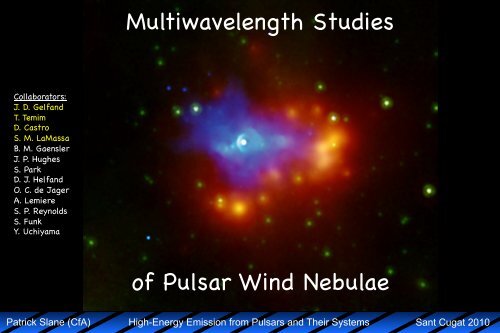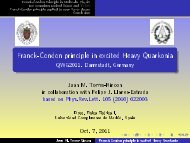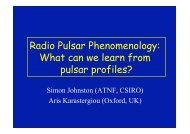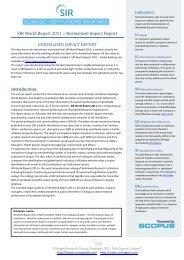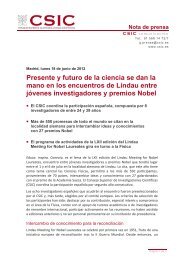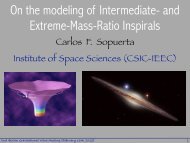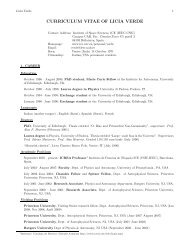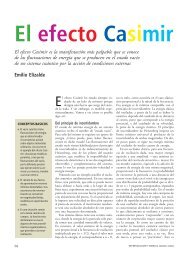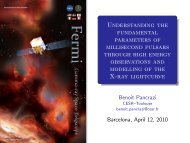Multiwavelength Studies of Pulsar Wind Nebulae
Multiwavelength Studies of Pulsar Wind Nebulae
Multiwavelength Studies of Pulsar Wind Nebulae
- No tags were found...
You also want an ePaper? Increase the reach of your titles
YUMPU automatically turns print PDFs into web optimized ePapers that Google loves.
<strong>Multiwavelength</strong> <strong>Studies</strong> !Collaborators:!J. D. Gelfand!T. Temim!D. Castro!S. M. LaMassa!B. M. Gaensler!J. P. Hughes!S. Park!D. J. Helfand!O. C. de Jager!A. Lemiere!S. P. Reynolds!S. Funk!Y. Uchiyama!<strong>of</strong> <strong>Pulsar</strong> <strong>Wind</strong> <strong>Nebulae</strong>!Patrick Slane (CfA)High-Energy Emission from <strong>Pulsar</strong>s and Their SystemsSant Cugat 2010
PWNe and Their SNRs!PWN ShockReverse ShockForward Shock<strong>Pulsar</strong> <strong>Wind</strong><strong>Pulsar</strong>TerminationShockPWNUnshocked EjectaShocked EjectaShocked ISMISM•! <strong>Pulsar</strong> <strong>Wind</strong>!- sweeps up ejecta; shock decelerates !flow, accelerates particles; PWN forms!Gaensler & Slane 2006!•! Supernova Remnant!- sweeps up ISM; reverse shock heats!ejecta; ultimately compresses PWN; energy distribution <strong>of</strong> particles in nebula tracks!evolution; instabilities at PWN/ejecta interface may allow particle escape!Patrick Slane (CfA)High-Energy Emission from <strong>Pulsar</strong>s and Their SystemsSant Cugat 2010
Jet/Torus and Ejecta Structure in PWNe!Crab Nebula (CXO+HST+SST)!Patrick Slane (CfA)High-Energy Emission from <strong>Pulsar</strong>s and Their SystemsSant Cugat 2010
•! G54.1+0.3 is a young !PWN !- termination shock and !jet-like outflow clearly !observed!The Surrounding Ejecta: G54.1+0.3!Patrick Slane (CfA)High-Energy Emission from <strong>Pulsar</strong>s and Their SystemsTemim et al. 2010!Sant Cugat 2010
•! G54.1+0.3 is a young !PWN !- termination shock and !jet-like outflow clearly !observed!•! PWN is surrounded by !a shell <strong>of</strong> IR emission!- IRS spectroscopy shows !dust continuum w/ lines !from rapidly-expanding !ejecta!The Surrounding Ejecta: G54.1+0.3!1!2!2!1!Patrick Slane (CfA)High-Energy Emission from <strong>Pulsar</strong>s and Their SystemsTemim et al. 2010!Sant Cugat 2010
The Surrounding Ejecta: G54.1+0.3!•! G54.1+0.3 is a young !PWN !- termination shock and !jet-like outflow clearly !observed!•! PWN is surrounded by !a shell <strong>of</strong> IR emission!- IRS spectroscopy shows !dust continuum w/ lines !from rapidly-expanding !ejecta!•! IR emission is from!freshly-formed ejecta !dust heated by stars!- Extended IR clump has !enhanced temperature !and density; possibly !compressed by jet!Patrick Slane (CfA)See High-Energy talk by E. Aliu: Emission Latest Results from on <strong>Pulsar</strong>s pulsar and environments Their Systems by VERITAS!Temim et al. 2010!Sant Cugat 2010
Broadband Emission from PWNe!Gelfand et al. 2009!•! Spin-down power is injected into the !PWN at a time-dependent rate!E ˙ = I" " ˙ = E ˙$1+ t '* n+1n*1& 0 # )% (•! Assume power law input spectrum:!!Q(t) = Q 0(t)(E e/ E b) "#- note that studies <strong>of</strong> Crab and other!PWNe suggest that there may be !!multiple components!•! Get associated synchrotron and IC emission !from electron population evolved nebula!- joint fitting <strong>of</strong> synchrotron and IC spectra !give B!Patrick Slane (CfA)High-Energy Emission from <strong>Pulsar</strong>s and Their SystemssynchrotronCMBinverseComptonSant Cugat 2010
Broadband Emission from PWNe!•! Spin-down power is injected into the !PWN at a time-dependent rate!E ˙ = I" " ˙ = E ˙$1+ t '& 0 % # )(* n+1n*1•! Assume power law input spectrum:!!Q(t) = Q 0(t)(E e/ E b) "#- note that studies <strong>of</strong> Crab and other!PWNe suggest that there may be !!multiple components!Gelfand et al. 2009!Gelfand et al. 2009!•! Get associated synchrotron and IC emission !from electron population evolved nebula!- joint fitting <strong>of</strong> synchrotron and IC spectra !give B!Patrick Slane (CfA)High-Energy Emission from <strong>Pulsar</strong>s and Their SystemssynchrotronCMBinverseComptonSant Cugat 2010
Injection from Relativistic Shocks!Spitkovsky 2008!•! PIC simulations <strong>of</strong> particle acceleration in relativistic shocks show build-up !<strong>of</strong> energetic particles (Spitkovsky 2008)!•! Multi-component input spectrum: Maxwellian + power law !– and possibly more complex if conditions differ at different acceleration sites!Patrick Slane (CfA)High-Energy Emission from <strong>Pulsar</strong>s and Their SystemsSant Cugat 2010
Broadband Observations <strong>of</strong> 3C 58!Slane et al. 2008!•! 3C 58 is a bright, young PWN!- morphology similar to radio/x-ray; suggests!low magnetic field!- PWN and torus observed in Spitzer/IRAC!•! Low-frequency break suggests possible!break in injection spectrum!- IR flux for entire nebula falls within the!extrapolation <strong>of</strong> the X-ray spectrum!- indicates single break just below IR!•! Torus spectrum requires change in !slope between IR and X-ray bands!- challenges assumptions for single power!law for injection spectrum!Patrick Slane (CfA)High-Energy Emission from <strong>Pulsar</strong>s and Their SystemsSant Cugat 2010
Evolution in an SNR: Vela X!LaMassa et al. 2008!de Jager et al. 2008!•! XMM spectrum shows nonthermal and ejecta-rich thermal emission from cocoon!- reverse-shock crushed PWN and mixed in ejecta? !•! Broadband measurements consistent with synchrotron and I-C emission from PL!electron spectrum w/ two breaks, or two populations!- density too low for pion-production to provide observed !-ray flux!- magnetic field very low (5 µG)!Patrick Slane (CfA)High-Energy See talk by A. Emission Pellizzoni: from Vela <strong>Pulsar</strong>s PWN unveiled and Their in gamma-rays! SystemsSant Cugat 2010
Evolution in an SNR: Vela X!LaMassa et al. 2008!Slane et al. – in prep!•! XMM large project to map cocoon and much <strong>of</strong> remaining nebula underway!Patrick Slane (CfA)High-Energy Emission from <strong>Pulsar</strong>s and Their SystemsSant Cugat 2010
HESS J1640-465!5 arcmin!•! Extended source identified in HESS GPS!- no known pulsar associated with source!- may be associated with SNR G338.3-0.0!•! XMM observations (Funk et al. 2007) identify extended X-ray PWN!•! Chandra observations (Lemiere et al. 2009) reveal neutron star within extended nebula!- L x "10 33.1 erg s -1 ! ! ~ 10 36.7 erg s -1!- X-ray and TeV spectrum well-described by leptonic model with B "6 µG and t "15 kyr!- example <strong>of</strong> late-phase <strong>of</strong> PWN evolution: X-ray faint, but !-ray bright!Patrick Slane (CfA)High-Energy Emission from <strong>Pulsar</strong>s and Their SystemsSant Cugat 2010
HESS J1640-465!Lemiere et al. 2009!LAT 1 yr!sensitivity!•! Extended source identified in HESS GPS!- no known pulsar associated with source!- may be associated with SNR G338.3-0.0!•! XMM observations (Funk et al. 2007) identify extended X-ray PWN!•! Chandra observations (Lemiere et al. 2009) reveal neutron star within extended nebula!- L x "10 33.1 erg s -1 ! ! ~ 10 36.7 erg s -1!- X-ray and TeV spectrum well-described by leptonic model with B "6 µG and t "15 kyr!- example <strong>of</strong> late-phase <strong>of</strong> PWN evolution: X-ray faint, but !-ray bright!Patrick Slane (CfA)High-Energy Emission from <strong>Pulsar</strong>s and Their SystemsSant Cugat 2010
HESS J1640-465!•! Extended source identified in HESS GPS!- no known pulsar associated with source!- may be associated with SNR G338.3-0.0!Slane et al. 2010!•! XMM observations (Funk et al. 2007) identify extended X-ray PWN!•! Chandra observations (Lemiere et al. 2009) reveal neutron star within extended nebula!- L x "10 33.1 erg s -1 ! ! ~ 10 36.7 erg s -1!- X-ray and TeV spectrum well-described by leptonic model with B "6 µG and t "15 kyr!- example <strong>of</strong> late-phase <strong>of</strong> PWN evolution: X-ray faint, but !-ray bright!•! Fermi LAT reveals emission associated with source!Patrick Slane (CfA)High-Energy Emission from <strong>Pulsar</strong>s and Their SystemsSant Cugat 2010
•! PWN model with evolved power !law electron spectrum fits X-ray!and TeV emission!- Fermi emission falls well above!model!HESS J1640-465!Slane et al. 2010!Patrick Slane (CfA)High-Energy Emission from <strong>Pulsar</strong>s and Their SystemsSant Cugat 2010
•! PWN model with evolved power !law electron spectrum fits X-ray!and TeV emission!- Fermi emission falls well above!model!HESS J1640-465!Slane et al. 2010!•! Modifying low-energy electron!spectrum by adding Maxwellian!produces GeV emission through!inverse Compton scattering!- primary contribution is from IR!from dust (similar to Vela X)!- mean energy (!"10 5 ) and fraction!in power law ("4%) consistent w/!particle acceleration models!Patrick Slane (CfA)High-Energy Emission from <strong>Pulsar</strong>s and Their SystemsSant Cugat 2010
•! PWN model with evolved power !law electron spectrum fits X-ray!and TeV emission!- Fermi emission falls well above!model!HESS J1640-465!Slane et al. 2010!•! Modifying low-energy electron!spectrum by adding Maxwellian!produces GeV emission through!inverse Compton scattering!- primary contribution is from IR!from dust (similar to Vela X)!- mean energy (!"10 5 ) and fraction!in power law ("4%) consistent w/!particle acceleration models!•! GeV emission can also be fit w/!pion model!- requires n 0 > 100 cm -3 , too large!for G338.3-0.3!Patrick Slane (CfA)High-Energy Emission from <strong>Pulsar</strong>s and Their SystemsSant Cugat 2010
G327.1-1.1: More (Reverse) Shocking Results!•! G327.1-1.1 is a composite SNR!for which radio morphology!suggests PWN/RS interaction!•! Chandra observations show!an <strong>of</strong>fset compact source w/!trail <strong>of</strong> nonthermal emission!extending back to radio PWN!- compact source is extended !and embedded in bowshock-!structure!- prong-like structures extend!from source, inflating bubble!in region cleared out by RS!Temim et al. 2009!Patrick Slane (CfA) High-Energy Emission from <strong>Pulsar</strong>s and Their Systems Sant Cugat 2010
G327.1-1.1: More (Reverse) Shocking Results!•! G327.1-1.1 is a composite SNR!for which radio morphology!suggests PWN/RS interaction!•! Chandra observations show!an <strong>of</strong>fset compact source w/!trail <strong>of</strong> nonthermal emission!extending back to radio PWN!- compact source is extended !and embedded in bowshock-!structure!- prong-like structures extend!from source, inflating bubble!in region cleared out by RS!Temim et al. 2009!Patrick Slane (CfA) High-Energy Emission from <strong>Pulsar</strong>s and Their Systems Sant Cugat 2010
Probing Composite SNRs With Fermi!•! G327.1-1.1 is a composite SNR!for which radio morphology!suggests PWN/RS interaction!•! Chandra observations show!an <strong>of</strong>fset compact source w/!trail <strong>of</strong> nonthermal emission!extending back to radio PWN!- compact source is extended !and embedded in bowshock-!structure!- prong-like structures extend!from source, inflating bubble!in region cleared out by RS!•! Good candidate for !-rays, !And…!Patrick Slane (CfA)High-Energy Emission from <strong>Pulsar</strong>s and Their SystemsSant Cugat 2010
Probing Composite SNRs With Fermi!•! Watch for studies <strong>of</strong> this and other such systems with Fermi!Patrick Slane (CfA)High-Energy Emission from <strong>Pulsar</strong>s and Their SystemsSant Cugat 2010
Summary!•! <strong>Multiwavelength</strong> studies <strong>of</strong> PWNe reveal:!- spin properties <strong>of</strong> central engines!- geometry <strong>of</strong> systems!- spatially-resolved spectra !- interaction with supernova ejecta!- presence <strong>of</strong> freshly-formed dust!•! These lead to constraints on:!- particle acceleration in relativistic shocks!- formation <strong>of</strong> jets!- physics <strong>of</strong> pulsar magnetospheres!- nature <strong>of</strong> progenitor stars!- early and late-phase evolution <strong>of</strong> pulsar winds!•! Current advances are being made across the electromagnetic spectrum,!as well as in theoretical modeling, and point the way for investigations!in virtually every wavelength band.Patrick Slane (CfA)High-Energy Emission from <strong>Pulsar</strong>s and Their SystemsSant Cugat 2010


